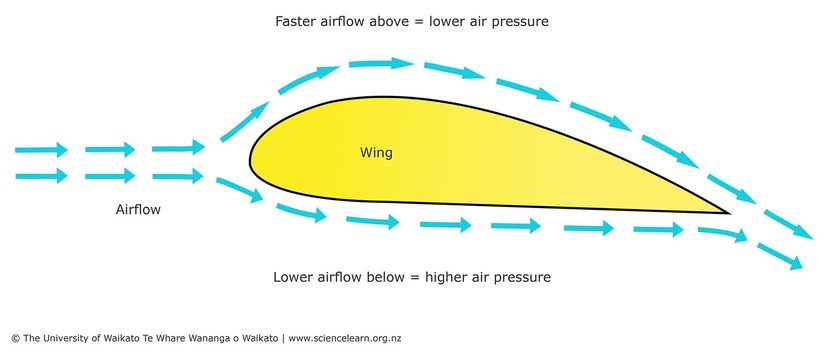
I’ve never really been bothered by turbulence – in fact, I quite enjoy it in mild levels as a fun distraction in an otherwise monotonous flight. However, I have been around more anxious fliers for whom even a little turbulence provokes a rather extreme reaction. It is for those poor souls that I write today’s article, in the hope that after reading it, they will finally be at ease.
First, let’s take a look at what actually allows planes to fly (anyone else feeling a hit of middle school nostalgia?). As it turns out, the science that most of us were taught regarding this topic is woefully incorrect. You might recall being taught that the wings of an aeroplane are curved, which forces air travelling above it – along the curved surface – to cover a longer distance to reach the other end (i.e. the tapering end) of the wing than the air travelling along the flat, lower side of the wing. In order for the air travelling above the wing to reach its tapering end at the same time as the air travelling below the wing, it has to travel faster, and this faster speed results in lower pressure. So now we find ourselves in a situation wherein the pressure levels above and below the wing are different. The pressure below the wing is higher than the pressure above the wing and therefore the resulting difference lifts the plane into the air.

While it is true that aeroplanes fly due to a pressure difference above and below their wings, the reason for this occurrence is completely different from the ‘longer path’ explanation we just read (and were most likely taught in school). The real reason for the pressure difference has to do with something called centripetal force.
Let’s imagine a plane gathering speed on a runway, preparing to take off. As it moves forward, the wings force the air to travel in different paths due to its curvature – and thus, the air has to split into two paths, one above the wing and one below. As the plane gathers speed, it also causes a layer of air to stick to the wings; this layer in turn pulls more air towards it. Now, when the air travelling above the wing hits its nose (i.e. the curve of the wing), it experiences a centripetal force which causes it to speed up (similar to the force you feel when a car takes a sharp turn). This increased speed results in lower pressure above the wing than below it, where the air travelling along the flat surface does not experience as much change in direction and speed. This is what causes the pressure difference that lifts the plane up – the greater the speed of the plane, the greater the pressure difference, until eventually it overcomes the downward force of gravity and we find ourselves cruising the skies.
As long as we maintain enough speed for this pressure difference to remain consistent, we will not fall out of the sky.
Now, what about turbulence? Even the calmest among us can’t help but feel a jolt of dread when unexpectedly strong winds seem to rattle a plane as if it were nothing more than a toy. But is turbulence really dangerous?
The short answer: no. What we sometimes fail to remember is that air is a fluid medium – it is simply less dense than water. Although this isn’t the scientific definition, a practical way to think of turbulence is like waves in the ocean that can rock a ship back and forth – all very natural, and nothing to worry about. The only time these ‘waves’ are dangerous is if they are strong enough to cause structural damage to a plane, but this is not an easy feat to accomplish. Modern aeroplanes are built to adapt to high levels of turbulence and withstand extreme stress – the kind which I’m fairly confident no one reading this has ever experienced. The only time one might start feeling concerned is if turbulence reaches a strength at which it causes the entire aeroplane to roll in the sky (imagine a ship capsizing). At this strength it might be possible for turbulence to damage a plane, but the chances of this happening are extremely rare.
So remember, if the turbulence is not strong enough to cause the plane to roll about in the sky, it is also not strong enough to cause the kind of damage needed to bring the plane down. You’re safe.
Works Cited
Adkins, Raymond. “How do airplanes actually fly?” TED-Ed. February 9th, 2023. Web. < https://www.youtube.com/watch?v=p4VHMsIuPmk > as seen on March 6th, 2023.
Goodwin, Grace Eliza and Morgan McFall-Johnsen. “What is turbulence, what causes it on an airplane, and why it's not usually dangerous” Insider. March 4th, 2023. Web. < https://www.insider.com/what-is-turbulence-causes-dangerous-airplanes-flight#:~:text=The%20FAA%20defines%20turbulence%20as,water%20will%20rock%20a%20boat. > as seen on March 6th, 2023.
Davis, Robert. “Is Turbulence Dangerous (Types, Severity, Plane Crash Stats)” Executive Flyers. January 18th, 2023. Web. < https://executiveflyers.com/is-turbulence-dangerous/#:~:text=Turbulence%20can%20rapidly%20change%20a,engineered%20to%20withstand%20immense%20trauma. > as seen on March 6th, 2023.
